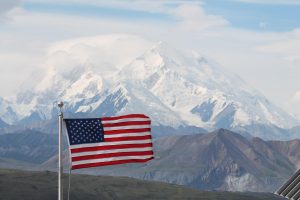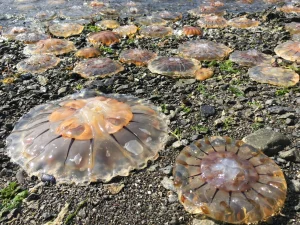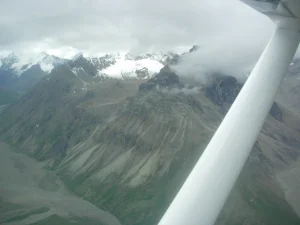A Fog Lifts on Wolverine Peak
by Thomas Pease
(Published in Anchorage Daily News, October 7, 2022)
If you climb Wolverine Peak in the Chugach front range, you might see the airplane wreckage just below the upper ridge as it turns east and leads to the summit. But it’s easy to miss if you aren’t looking for it. About 30 or so yards downhill from the rocky path, the weather-darkened, welded airframe blends in with the surrounding slate-gray rock and lichen. Any distinguishing paint or markings have long since been sand blasted away by the Williwaws that scream down the valleys to the east.
A running coach introduced me to Wolverine in the mid-1970’s when I was in junior high. Back then, there was no obvious trail leading up the mountain, but the most logical way to navigate the slope took hikers by the wreckage. I never gave the crash site much thought. As a young adolescent, I was more focused on social acceptance and my rank on the running team than on the rare sight of an airplane wreck.
Over the next decades, I climbed Wolverine dozens of times. Sometimes I would make the round trip without noting the wreckage, my thoughts straying elsewhere or fog obscuring the debris. Yet at some point well into my thirties, my indifference toward the desolate crash scene changed to curiosity. What kind of plane? Who was on board? When had it crashed? Was it weather-related? Pilot error? Mechanical failure? Had anyone survived? I always paused when I reached that point on my ascent and would scan the steep, rocky slope until I located the wreckage. But I never sought answers.
Then last fall, on a gray, drizzly day, I left the Wolverine trail near the summit and dropped down into a drainage in search of blueberries. The descent was steep, and recent rains had turned wet rocks and soggy tundra into tenuous footholds. Near the bottom, the drainage narrowed into a shallow gulley. I stayed high, paralleling the gulley, side-hilling to my right, avoiding water and scrub brush in the bottom of the drainage itself. Blueberries greeted me on the lower tundra where water and soil allow the plants to flourish. I moved downhill, picking berries as I went, lost in a berry-picker’s reverie. At some point, I stood upright to uncoil the kinks in my back.
Just a few yards downhill from me sat an engine, upright in the same position it would have been mounted in an aircraft. I recognized it as a large radial engine with nine cylinders arranged in a circle; the same type of engine that powers de Havilland Beavers, Alaska’s aviation workhorses. Now I was truly puzzled. Questions fired in my head like the pistons on the radial engine once had. Logic would indicate that the engine was part of the plane that crashed near the top of the ridge. Yet a half mile and 800 vertical feet separated it from the airframe, and it appeared newer, less weathered. Could it be from a second, more recent crash? It wouldn’t be the first time an Alaskan mountain had claimed multiple planes. I took photos before I walked out, haunted by the prospect that Wolverine Peak, my backyard mountain, held more than one graveyard.
I was determined to finally discover the story behind the perplexing scene. But life interrupted my best intentions, and another year passed without investigating the crash —or crashes—further. This year, I returned to Wolverine in early August for blueberries and dropped down into the Wolverine bowl again. This time, I held to the gulley, and near the bottom, discovered landing gear with yellow paint and a fleck of blue, and a Good Year tire still intact. It took some time to locate the engine again, farther downhill than I remembered, perhaps 50 yards below the wheel strut. This time, I took multiple photos, including serial numbers whenever I could locate them. I studied the debris, then sighted along an uphill trajectory into the fog where I knew the airframe rested. The distance seemed too great to be from the same plane, unless an avalanche swept part of the wreckage to the bottom of the gulley. But why would the engine, the heaviest part of the plane, be carried the greatest distance in an avalanche?
I immediately sent a text with the photos to a friend who is a commercial airplane mechanic. Within hours, I received a reply, and with it, answers to my questions.
On June 9, 1956, The Anchorage Times identified the plane as a blue single-engine Howard that went missing the previous day and was feared down somewhere in the Chugach Mountains with five people aboard. The pilot’s last radio transmission was around 11:30 AM on June 8th when he reported approaching from the southwest at 5,000 feet for Merrill Field.
The pilot had just purchased the used Howard in Washington DC and was on the final leg of a multi-day flight to Anchorage where he was stationed in the military. The party had taken off from Northway that morning with Merrill Field its final destination. Or would have been. But a fast-moving fog enveloped the plane, obscured visibility, and caused it to stray east of its final approach. The plane cleared a lower ridge to the south before slamming into the front face of Wolverine at around 4,000 feet. The engine sheared off on impact and tumbled downhill, while the main portion of the plane continued uphill, bounced multiple times and came to rest 100’ below the top of the ridge. The wreckage then caught fire. All five people on board perished.
I know their names now, all five of them: The pilot, Elbert Head, 28, of the Alaskan Air Command; his mother, Mrs. J. C. Head, of Birmingham, Alabama, Mrs. Wallace Hess of Dallas, Texas and wife of Master Sergeant Hess of the 64th Fighter Interceptor Squadron; and George Hogue and W. K. Tanner, both of Birmingham.
The engine, a wasp junior, was manufactured by Pratt and Whitney, based on the photos and serial number. It was the same engine installed in the Howard model DGA-15p. The wheel and strut belonged to the Howard as well, identified by a distinctive towing ring welded forward of the wheel. The far-flung debris was all from the same plane.
Later in the month, I returned, hiking up Wolverine more slowly than usual. It was drizzly and my bare forearms tingled from the wet chill, but the uphill exertion made a second layer unnecessary. I stopped several times as the trail turned east and steepened. I needed to catch my breath, post-Covid, but more than that, the vistas beckoned to the south and west. Directly below me, O’Malley Road, one of the few pioneer roads laid out in a perfectly straight line. Farther west, Lake Hood and the Spenard neighborhood, which, in 1956 was an independent entity with its own post office. Just offshore, Fire Island, lolling in the muddy shallows of Cook Inlet, like a giant cetacean scratching barnacles off its back. Beyond that, Mt. Susitna, with a sprinkling of termination dust.
Facing east and resuming my climb, the landscape was more ominous. Black clouds plugged the middle and north forks of Campbell Creek. A thick fog bank hid Wolverine’s summit. Weather not uncommon in the Chugach Mountains; weather not unlike what ensnared the Howard and its pilot. The airframe gradually took shape, like an apparition, to my right. I side-hilled over to it and stopped.
I gauged the distance across the Anchorage Bowl. The Howard came so close. Just seven miles shy of Merrill Field. Just 300 vertical feet below the crest of the ridge.
The fog bank slowly lifted. The same stunning landscapes the victims might have viewed through the windows of the Howard lay before me. So much life and so many adventures ended on the alpine tundra. Five faceless victims imprinted on the face of a mountain. Those five souls, young and old alike, poised for a love affair with Alaska. Alaska displays a wildness we all fall in love with, a beauty that keeps us here. But its wild beauty sometimes exacts a price. It’s a tenuous relationship, I remind myself, one that we cling to but have little control over.
As I descended into the drainage where the Howard’s engine rests, I noticed a burst of color, a flourish of paint on a weathered August landscape. The wildflowers— geraniums, wild iris, monks hood, fleabane—got a late start after a record winter snowfall covered mountain slopes well into summer. They were likely blooming on that day when Wolverine Peak became a permanent home for the Howard. Now, fittingly, another generation of wildflowers honors the Howard Five in their unmarked graves.





